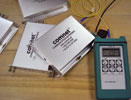

ComNet talks about lighting up dark fibre.
Optical fibre has been one of the better signal transmission solutions introduced to the security industry. About 20 years ago when the potential of fibre-optic transmission was realised, a mass installation started.
Fibre-optic transmission delivers miles of high bandwidth transmission capabilities. During the fibre-optic boom, it was everywhere. Even without planned use, it was installed in buildings, campuses, stadiums, factories and more. The thinking was it was cheaper in the long run to put it in during the construction phase than try to install it later.
Now, years later this optical fibre, having never been used is known as dark fibre. Dark, not in colour, but because light has never passed through it or not been used. It may be just installed or installed to the point of the connectors; LC, ST or SC may have even been installed. But just because the fibre has never been used, does not mean it is not good.
The most substantial benefit to using dark fibre is the cost savings. The cost to pull new optical fibre is not inexpensive. Typical optical fibre costs range from $0,08 per foot per strand for single mode fibre to $0,12 per foot per strand for multimode fibre. Realistically fibre is pulled in multiple strands jacketed together, and the general estimate is that it is usually 10-20 times the cost of the medium for installation based on location and installation difficulties. So the obvious benefit to using dark fibre is the tremendous cost savings gained by utilising it.
There is a downside to optical fibre that has never been used. The potential disadvantages include the lack of information about the fibre, fibre path, or the fibre history. Some of the questions that arise regarding dark fibre include:
* Was the fibre pulled correctly or was excessive stress or strain applied? If too much force is used, damage to the optical fibre can occur. Trying to track back a damaged fibre is extremely difficult and in reality should any damage be identified the fibre is usually abandoned.
* Does the fibre cable contain the proper jacket for the environment? The type of jacket used dictates where it can be used. There are water resistant jackets, temperature resistant jackets.
* What type of fibre is installed?
* If the fibre is multimode, could the fibre be:
- old, relatively useless step-index multimode fibre?
- graded index 50/125 μm or 62,5/125 μm multimode fibre?
- LASER-optimised 50/125 μm multimode fibre?
* If the fibre is terminated, was it terminated properly?
* What is the nature of the optical path?
- Are there patch panels and splices along the way?
- If so, how many, where are they, and what is their condition?
- What is the end-to-end optical path loss?
- Was the minimum bend radius considered when installing fibre around corners or bends?
* Is documentation available that would show parameters such as optical attenuation coefficients, bandwidth-distance products, or dispersion?
If the above conditions are satisfied, the next step is to determine the continuity of the fibre. That is, is the dark fibre suitable to be used for transmission? To determine the suitability of a fibre for transmission, the optical path must be confirmed.
Warning
Never look into an optical fibre or into an inspection device that is connected to a fibre unless you can guarantee that nothing is connected to the other end of the fibre or to any access points along the optical path such as path panels. Irreversible damage could be done to your eye before you could have the chance to react.
This paper will be concluded in the June issue of Hi-Tech Security Solutions.
For more information contact ComNet Europe, +44 113 307 6400, [email protected], www.comnet.net

© Technews Publishing (Pty) Ltd. | All Rights Reserved.